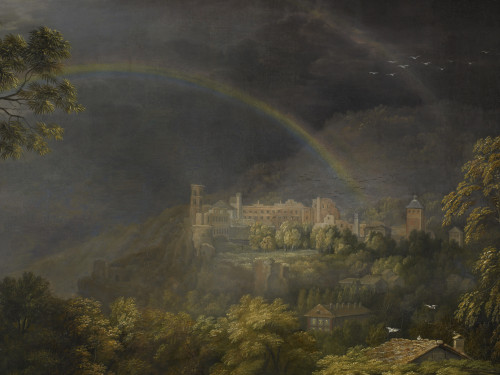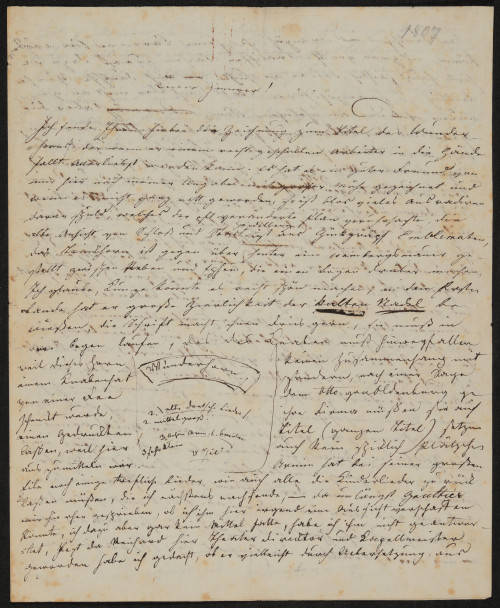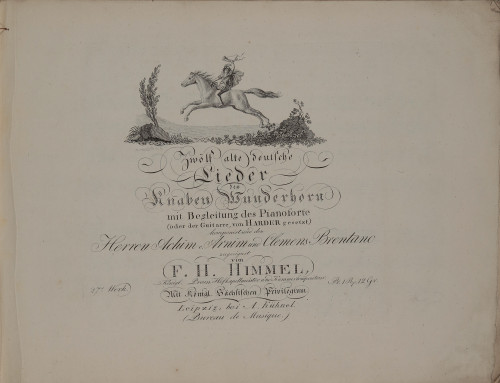Wenn ich ein Vöglein wär; Schlaf, Kindlein, schlaf, … Many old German folk songs are still well known today. That is due in part to The Boy’s Magic Horn, a collection compiled by the friends Achim von Arnim and Clemens Brentano. The simple, catchy folk melodies had already sparked their enthusiasm during their trip down the Rhine. So they began collecting obscure and all-but-forgotten song lyrics. Others before them had done the same, among them Johann Gottfried Herder, who had won Goethe’s support for his project and coined the term “Volkslied”, or “folk song”, in 1773. These songs were long considered artless and crude. In the Romantic age, however — against the background of the Napoleonic wars —, such testimonies to the past drew increasing attention.
In 1805, Arnim went to see his friend in Heidelberg, where they prepared the first volume, subtitled “Old German Songs”, for publication within a few weeks. In fact, it contained not only historical finds, but also adaptations and lyrics of their own. This corresponded to their romantic approach, because their aim was not scientific documentation, but the poems’ widest possible circulation.
The material was quite abundant. Others helped collect it, for example the Brothers Grimm and Bettine Brentano. The first volume, printed in September 1805 and antedated 1806, was followed in 1808 by two more. The title pages were designed with great care: that of volume 1 depicts a boy on horseback holding up a bugle, that of volume 2 a richly decorated drinking horn with a view of Heidelberg in the background. The cover of the third portrays a musicmaking couple of the Gothic period and — fittingly for a volume containing children’s songs — a forest with a Nativity scene. Heidelberg Castle, unlike its depiction in the second volume, had been in ruins since the late seventeenth century. And that is how it is portrayed in the painting of 1812 by the Scottish artist George Augustus Wallis, also on view in this installation. The Magic Horn volumes did not include musical notation, but some of the songs were soon set to music.
Arnim and Brentano had dedicated the first volume to Goethe, who lost no time in publishing an appreciative critique. He will have recalled his time in Strasbourg in 1771, when he himself was involved in Herder’s international collection of folk songs. Goethe did not entirely approve of the Romantics’ limitation to German literature, but he nevertheless stated that: “This little book should, by law, be present in every home.” The many editions that followed the Magic Horn’s first reprint of 1819 have continued to make that presence possible to this day.
Objects
-

ACHIM VON ARNIM, CLEMENS BRENTANO
Des Knaben Wunderhorn. Alte deutsche Lieder gesammelt von L. A. v. Arnim und Clemens Brentano
(Band 1.) Heidelberg: Mohr und Zimmer; Frankfurt a. M.: Mohr 1806. Band 2. Heidelberg: Mohr und Zimmer 1808.
-

GEORGE AUGUSTUS WALLIS
Das Heidelberger Schloss unter doppeltem Regenbogen, 1812
-

CLEMENS BRENTANO
Letter to Johann Georg Zimmer, Kassel, January 25, 1808
-

FRIEDRICH HEINRICH HIMMEL
Zwölf alte deutsche Lieder des Knaben Wunderhorn mit Begleitung des Pianoforte (oder der Guitarre, von Harder gesetzt) komponirt und den Herren Achim v. Arnim und Clemens Brentano zugeeignet von F. H. Himmel
Leipzig: Kühnel 1808.